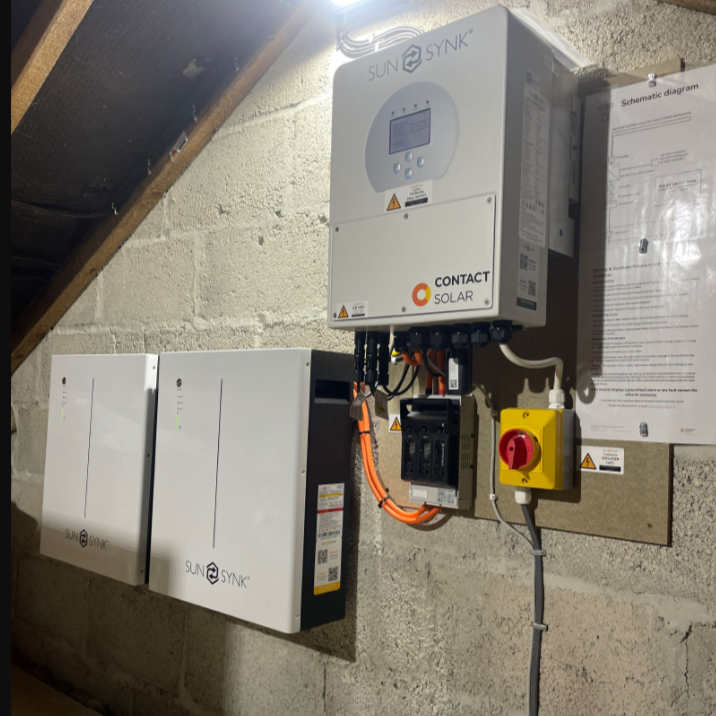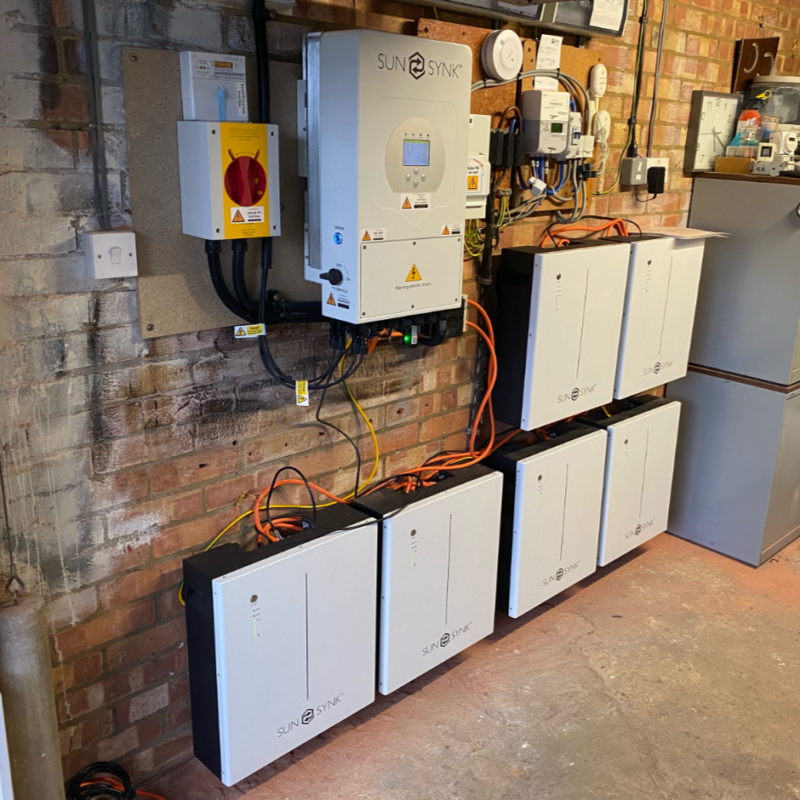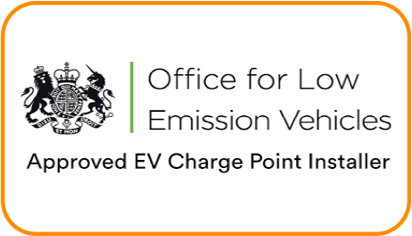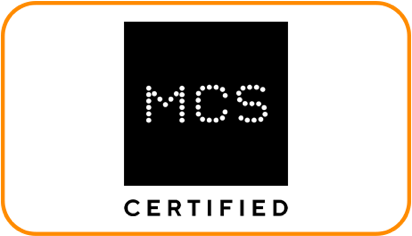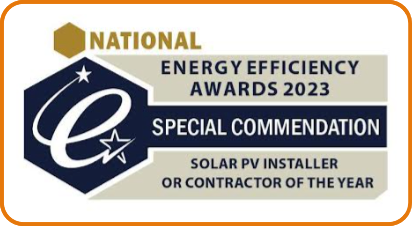As the winter months approach, it’s important to understand what to expect from your solar PV system – and how to prepare your solar panels in winter.
So: how do solar panels perform in winter (UK)? While sunlight levels are lower in winter, modern solar panels generate electricity year-round, and panel efficiency increases in cooler temperatures. With some simple preparation, such as keeping your panels clear and unobstructed, investing in extra battery storage and taking advantage of off-peak energy rates, you can keep your solar PV battery system running efficiently all season long.
At Contact Solar, our mission is to help our customers get the absolute most out of their solar PV systems. This comprehensive guide to solar PV winter-proofing will help you ensure your system continues to perform well throughout the colder months.
Add Extra Solar Battery Storage
Occasionally, we are asked about solar panel output in winter vs. summer. UK winters have characteristically short days, meaning your solar panels will produce less electricity. So, while your system will continue to harness solar energy during winter, you may need to draw energy from the grid more often.
Adding additional battery storage to your solar PV system can help you save money on your energy bills when light levels are lower by charging from the grid at a cheaper rate. An extra battery, such as the Sunsynk 5.32kWh batteries we use at Contact Solar, will give you more capacity to store cheaper off-peak electricity for later use. On sunny winter days, when solar production is higher, you can also store additional excess solar power. This can help you to maximise self-consumption and reduce grid dependence.
To explore whether an additional battery could benefit you, get in touch with Contact Solar. Our trained advisors will happily recommend the right amount of battery storage for your needs.
Switch to a Multi Rate Tariff
Another tip to help you make the most of your solar PV system in winter is to move to a multi rate or split rate electricity tariff. This kind of plan offers cheaper electricity during off-peak hours.
Most electricity suppliers offer some form of multi rate tariff, so there is plenty of choice available. Some have special tariffs for customers with solar PV systems which also offer premium rates for selling energy to the grid.
Traditional ‘Economy 7’ plans offer reduced rates for seven hours during the night, e.g. between 11pm-6am or 12am-7am. Some newer tariffs are more dynamic, with prices fluctuating throughout the day according to supply and demand.
With a multi rate tariff, you can set your solar batteries to charge while electricity is cheaper. You can then use the stored energy on days when your solar panels aren’t generating enough power. The more battery storage you have, the less electricity you’ll need to draw from the grid during peak times. The support team at Contact Solar can advise you on a tariff’s compatibility with your system.
Keep Your Solar Panels Clear
Solar panels are low-maintenance and require very little attention throughout the year. In fact, thanks to their hydrophobic coating, they are considered to be self-cleaning. Dust, dirt, leaves and other debris are normally cleared by rain, and snow on solar panels slides off when it begins to melt.
However, to ensure optimum solar production in winter, it’s worth ensuring that your array is clear and free from anything blocking the light. For example, this might include a buildup of fallen leaves, or shade from a tree that needs pruning. Clear, unobstructed panels mean you can continue harnessing free energy from the sun year-round.
If you notice any debris that does not clear on its own, solar panels can be rinsed with water. There is need to use cleaning products. If you prefer, you can hire a professional to do this – window cleaners often offer a solar panel cleaning service.
Understand How Cold Temperatures Affect Solar Panels in Winter
If you are wondering “do solar batteries work in the winter?” the answer is yes. Solar battery storage systems perform well year-round. The working temperature for Sunsynk 5.32kWh batteries, for example, is -20°C ~ 60°C.
Solar batteries come with a built-in battery management system (BMS), which keeps the battery working efficiently over its lifespan. The BMS automatically adjusts things like charge rates in low temperatures, protecting the battery and ensuring optimal performance.
This means there may be some differences in how your battery functions in cold weather. If the temperature of the lithium drops below ~12.5°C, you may notice:
- Reduced capacity – the battery may not store as much energy
- Slower charge rates – the battery may take longer to reach full capacity
- Faster discharging – the energy stored in the battery may drain quicker
When internal temperatures fall below freezing, some solar batteries are designed to temporarily stop charging as a safety measure. This is because there is a potential risk of damage if batteries are exposed to sustained cold while charging.
All of the above is completely normal, and a sign that your batteries are functioning as intended. It is a necessary feature put in place by the BMS to help protect and balance the cells. Without it, your solar battery’s capacity and lifespan could be permanently reduced.
External vs. Internal Solar Battery Temperature
With solar batteries, there is a big difference between external temperatures and internal temperatures. When we talk about charge rates changing below ~12.5°C, this means the temperature inside the battery – not the ambient room temperature.
As lithium ion batteries heat up while charging and discharging, their internal temperature is usually higher than the surrounding environment. So, even if the room thermometer reads 10°C (for example), the battery cells may be much warmer.
The majority of people store their solar batteries in their garage or loft without issue. During summer, batteries placed in loft spaces can see an improved performance due to increased temperatures.
It’s important to check the internal temperature of your batteries rather than going by room temperature. You can do this remotely through your inverter monitoring portal.
New Customer Support Feature from Sunsynk
If you have any concerns about your solar PV or battery storage system, the Contact Solar support team is always on hand. We have a number of tutorial videos available on our website, and you can contact us directly via phone or email.
However, you can also now speak to trained solar advisors 24/7 over live chat through the Sunsynk app. See our how-to video below to learn how to access Sunsynk’s brand-new Customer Support feature.
Preparing Your Solar System for Winter: Frequently Asked Questions
1. Do Solar Panels Work in Winter (UK)?
Yes, solar panels are capable of generating a significant amount of electricity in winter. Modern solar PV technology works year-round, and it functions best in cold weather. It’s worth noting that output is typically lower in winter than at summer peak, due to reduced daylight hours. However, solar panels can still produce plenty of free renewable energy for your home during winter, especially on bright and sunny days.
2. How Much Do Solar Panels Generate in Winter (UK)?
In the UK, you can expect your solar panels to lose efficiency through December and January compared to the summer months. This is due to shorter days and diffuse, low-angle sunlight. The actual amount generated will depend on factors like the number and type of solar panels, hours of sunlight and cloud cover in your area. Investing in battery storage, allowing you to store energy for later, can help you make the most of your solar panels in winter.
3. Does Cold Weather Affect Solar Panels in Winter?
As long as there is sunlight, your solar PV system will produce electricity, regardless of the temperature outside. In fact, in cold weather, solar panels work more efficiently than on warmer days. Though your total daily solar production may be lower due to reduced sunlight hours, you can rest assured that cold temperatures will not damage your panels or stop them generating power.
4. How Does Cold Weather Affect Solar Batteries?
The lithium-ion batteries used in solar energy storage can be adversely affected by cold temperatures. So, solar batteries come with a built-in battery management system, designed to optimise their performance in all temperatures. On cold days, you may notice that your battery charge rate is reduced, or that they need to recharge more frequently. Some batteries may also restrict charging below freezing temperatures as a safety measure. This is completely normal and nothing to worry about.
5. What Temperature Should Solar Batteries Be Kept At?
The ideal solar battery temperature range may vary depending on the product, so always consult the manufacturer’s guidelines. The operational range for the Sunsynk batteries we use at Contact Solar is -25-60°C, meaning they can withstand seasonal temperature variations with ease. In terms of battery charge rates, peak performance can be expected above 12.5°C (internal temperature). You may notice slower charging below this temperature, which is a normal and necessary feature of the BMS.
6. How Do I Check the Temperature of My Solar Batteries?
Most solar battery systems have integrated temperature sensors. You should be able to access a range of data, including inverter and battery temperatures, through your inverter monitoring portal. If you are unsure how to check the temperature of your solar batteries, consult the product manual or contact your installer for assistance. Our advisors at Contact Solar will be happy to provide guidance based on the system installed within your property.
7. How Do I Keep My Solar Battery from Freezing?
Proper temperature control will keep your solar batteries operating smoothly and can help extend their lifespan. This largely depends on their location. When selecting where to house your solar battery system, choose a cool, dry, well-ventilated area with stable temperatures, away from extreme heat or cold. Most people keep their solar batteries in their loft or garage and do not experience any problems. If you have any insulation concerns, always check with your installer and your home insurance provider before making any modifications. DIY insulation is not recommended by Contact Solar.
8. Do I Need to Change My Battery Settings in the Winter?
Though it’s not a requirement, you may wish to consider adjusting your solar battery’s charging settings for the winter months. If you have a multi rate tariff, you can take advantage of off-peak energy prices by programming your batteries to charge from the grid overnight. This allows you to store cheap energy to use during the day, saving you money when you can’t rely solely on solar power. Consult your instruction manual for details on how to do this. To learn how to set battery charge times on your Sunsynk monitoring portal, see our tutorial videos.
9. Why Am I Exporting Power When My Batteries Are Not Full?
This common winter phenomenon is usually caused by low solar battery temperatures. Most lithium-ion solar batteries, such as Sunsynk, need to stay above ~12.5°C to charge at their full rated speed. If your solar panels are generating power faster than your battery can charge, the excess has nowhere to go but out to the grid. This is why, in cold weather, you may see energy exporting before the battery reaches full capacity.
10. Why Is My Solar Battery Not Working in Cold Weather?
In very cold conditions, many lithium-ion solar batteries are designed to shut down as a protective measure. This is because charging in freezing temperatures can cause permanent damage. Sunsynk batteries, for example, will not accept charge when the internal temperature is below 0°C (though they will continue to discharge at lower temperatures). If your battery stops working, first check that the internal battery temperature has not dropped too low. Contact your installer if issues persist in normal temperatures.
Interested in Expanding Your Battery Storage? Choose Contact Solar
Contact Solar has been designing and fitting bespoke solar solutions across the UK since 2012. As one of the nation’s most trusted solar PV installers, we are passionate about helping our customers get the most out of their investment. Our Which? Trusted Trader status and 5-star reviews reflect our commitment to quality and service.
If you are considering expanding your solar battery storage this winter, or have any questions, get in touch today. Our experts will happily provide tailored recommendations on the ideal solar battery storage solution for your home or business.
Speak to our friendly advisors to learn more and receive your free, no-obligation quote. Call Contact Solar on 0800 201 4527, email [email protected] or fill in our quick online quote form.
